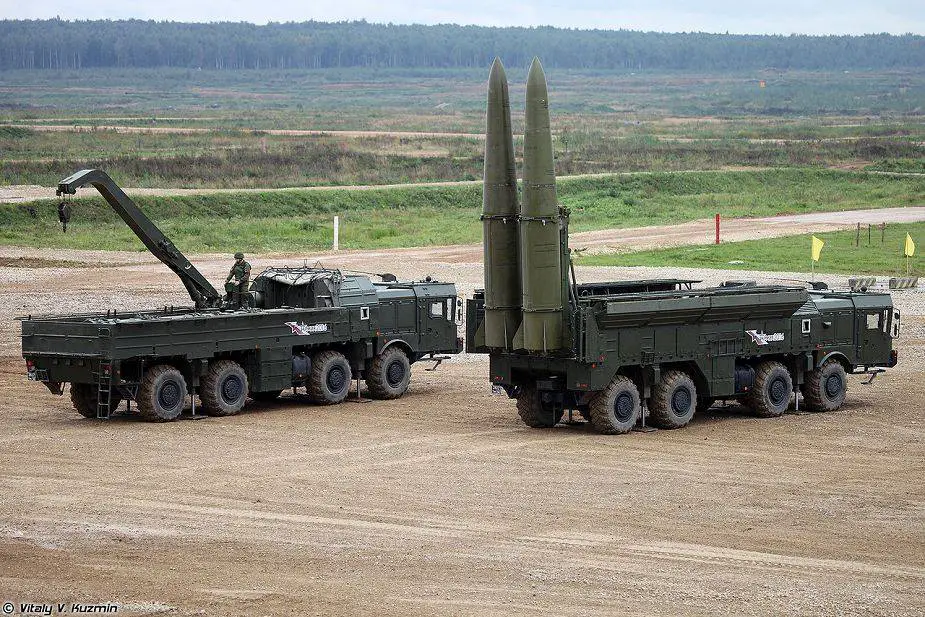Missile brigades of Russian Ground forces to interact with Navy
Missile brigades of the Russian Ground Forces will closely interact with the Navy from 2021. Iskander-M missiles (SS-26 in NATO code) will support naval operations at a distance of 500 km and precisely destroy adversary targets, such a coastal facilities and hardware, air bases, radars and command posts, the Izvestia daily writes.
Follow Army Recognition on Google News at this link

Iskander-M (Picture source: Vitaly Kuzmin)
The missile brigades with Iskander-M will provide fire support to Navy operations from 2021. The new concept will be tested at the upcoming Zapad-2021 strategic exercise, Defense Ministry sources said. Forpost navy drones will provide guidance to the missiles. Western Military District Commander Colonel-General Alexander Zhuravlev spoke about an experiment in early July 2020. A missile brigade of the Ground Forces destroyed unnamed targets in the central sea range in Arkhangelsk region. In the same month, Iskander trained repelling an amphibious assault and assisting the Black Sea fleet.
Most Iskander-M are operated by the Ground Forces. Coastal navy forces have one missile brigade with them. It is deployed in Kaliningrad region and operates in the 11th army corps. The 9K720 Iskander (NATO reporting name SS-26 Stone) is a mobile short-range ballistic missile system produced and deployed by the Russian Federation. The missile systems are to replace the obsolete OTR-21 Tochka systems, still in use by the Russian armed forces, by 2020. The Iskander has several different conventional warheads, including a cluster munitions warhead, a fuel-air explosive enhanced-blast warhead, a high explosive-fragmentation warhead, an earth penetrator for bunker busting and an electromagnetic pulse device for anti-radar missions. The missile can also carry nuclear warheads. In September 2017, the KB Mashinostroyeniya (KBM) general designer Valery M. Kashin said that there were at least seven types of missiles (and "perhaps more") for Iskander, including one cruise missile.
In December 2020, Defense Minister Sergey Shoigu said inter-arm exercises would become a priority in 2021. The Ground Forces, the Navy and the Aerospace Forces will act together and under a single leadership. The Defense Ministry said the number of such exercises grew three times in eight years.
Navy Commander-in-Chief Admiral Nikolai Yevmenov earlier said the Navy had created 20 tactical groups for operations in inter-arm forces. Several months ago, the Baltic fleet trained joint actions with the 6th combined arms army at command-staff exercises.
The Navy is always engaged in an army operation with a coastal flank, former Navy Chief-of-Staff Admiral Valentin Selivanov said."Iskander can fight coastal targets. The complexes in the Baltic area can reach all the shores of the sea. You do not have to send bombers, but fire Iskander instead. The missiles can back landing operations, as an amphibious assault of marines is only the first leap forward followed by land forces. Their missile brigades can be engaged in joint operations,” he said,
Iskander will not be more effective against warships than Bastion systems, but they can be useful against stationary targets, leading expert of the Center of Navy Analysis Mikhail Kofman said. Russia currently has insufficient capabilities to detect them at distances over 200 km and destroy them by Iskander. Satellite intelligence resources are limited. Naval aviation has few drones with a long flight duration. It is therefore appropriate to fire missiles at ground targets, the expert said.
“Iskander can strike at stationary and semi-stationary targets, such as radars, navy aviation bases, headquarters and communication hubs, and facilities with a good air defense. Naturally, Kalibr cruise missiles can do the job, but Russian warships carry only 8-16 launchers with them, while a land brigade can be rapidly recharged. Its survivability is higher in case of a retaliation strike,” he said.
Russia has been supplying Iskander-M to the troops since 2010. All existing and several newly formed missile brigades were rearmed with new missiles by 2020. Their total number in the armed forces reached thirteen, the Izvestia daily said.
© Copyright 2021 TASS / Army Recognition Group SPRL . All rights reserved. This material may not be published, broadcast, rewritten or redistributed.


























